在Spring Boot中如何使用数据缓存
发布于 2018-03-10 03:27:35 | 236 次阅读 | 评论: 0 | 来源: 网友投递
Spring Boot
Spring Boot 项目旨在简化创建产品级的 Spring 应用和服务。你可通过它来选择不同的 Spring 平台。可创建独立的 Java 应用和 Web 应用,同时提供了命令行工具来允许 'spring scripts'.
本篇文章主要介绍了在Spring Boot中如何使用数据缓存,具有一定的参考价值,有兴趣的可以了解一下。
在实际开发中,对于要反复读写的数据,最好的处理方式是将之在内存中缓存一份,频繁的数据库访问会造成程序效率低下,同时内存的读写速度本身就要强于硬盘。Spring在这一方面给我们提供了诸多的处理手段,而Spring Boot又将这些处理方式进一步简化,接下来我们就来看看如何在Spring Boot中解决数据缓存问题。
创建Project并添加数据库驱动
Spring Boot的创建方式还是和我们前文提到的创建方式一样,不同的是这里选择添加的依赖不同,这里我们添加Web、Cache和JPA依赖,如下图:
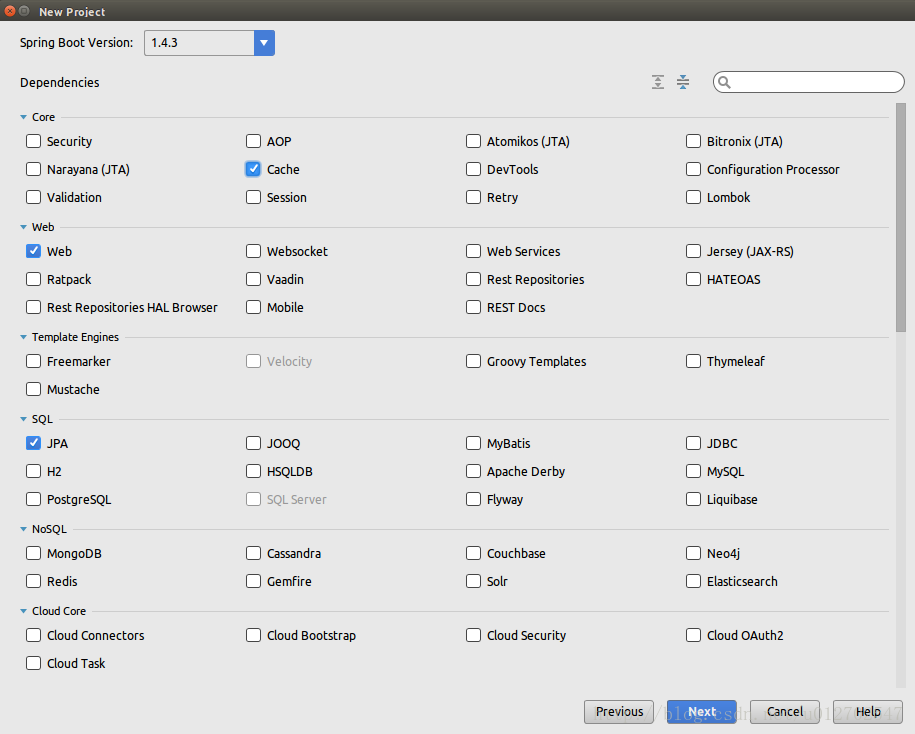
创建成功之后,接下来添加数据库驱动,我还是使用MySQL,在pom.xml中添加数据库驱动,如下:
<dependency>
<groupId>mysql</groupId>
<artifactId>mysql-connector-java</artifactId>
<version>5.1.40</version>
</dependency>配置application.properties
这个application.properties的配置还是和初识在Spring Boot中使用JPA一样,各个参数的含义我这里也不再赘述,我们直接来看代码:
spring.datasource.driver-class-name=com.mysql.jdbc.Driver
spring.datasource.url=jdbc:mysql://localhost:3306/sang?useUnicode=true&characterEncoding=utf-8
spring.datasource.username=root
spring.datasource.password=sang
spring.jpa.hibernate.ddl-auto=update
spring.jpa.show-sql=true
spring.jackson.serialization.indent_output=true
创建实体类
@Entity
public class Person {
@Id
@GeneratedValue
private Long id;
private String name;
private String address;
private Integer age;
public Person() {
}
public Long getId() {
return id;
}
public void setId(Long id) {
this.id = id;
}
public String getName() {
return name;
}
public void setName(String name) {
this.name = name;
}
public String getAddress() {
return address;
}
public void setAddress(String address) {
this.address = address;
}
public Integer getAge() {
return age;
}
public void setAge(Integer age) {
this.age = age;
}
public Person(Long id, String name, String address, Integer age) {
this.id = id;
this.name = name;
this.address = address;
this.age = age;
}
}
创建实体类的Repository
public interface PersonRepository extends JpaRepository<Person,Long> {}创建业务类
业务接口
public interface DemoService {
public Person save(Person person);
public void remove(Long id);
public Person findOne(Person person);
}
实现类
@Service
public class DemoServiceImpl implements DemoService {
@Autowired
PersonRepository personRepository;
@CachePut(value = "people", key = "#person.id")
@Override
public Person save(Person person) {
Person p = personRepository.save(person);
System.out.println("为id、key为" + p.getId() + "数据做了缓存");
return p;
}
@CacheEvict(value = "people")
@Override
public void remove(Long id) {
System.out.println("删除了id、key为" + id + "的数据缓存");
personRepository.delete(id);
}
@Cacheable(value = "people", key = "#person.id")
@Override
public Person findOne(Person person) {
Person p = personRepository.findOne(person.getId());
System.out.println("为id、key为" + p.getId() + "数据做了缓存");
return p;
}
}@Service
public class DemoServiceImpl implements DemoService {
@Autowired
PersonRepository personRepository;
@CachePut(value = "people", key = "#person.id")
@Override
public Person save(Person person) {
Person p = personRepository.save(person);
System.out.println("为id、key为" + p.getId() + "数据做了缓存");
return p;
}
@CacheEvict(value = "people")
@Override
public void remove(Long id) {
System.out.println("删除了id、key为" + id + "的数据缓存");
personRepository.delete(id);
}
@Cacheable(value = "people", key = "#person.id")
@Override
public Person findOne(Person person) {
Person p = personRepository.findOne(person.getId());
System.out.println("为id、key为" + p.getId() + "数据做了缓存");
return p;
}
}
关于这个实现类我说如下几点:
1.@CachePut表示缓存新添加的数据或者更新的数据到缓存中,两个参数value表示缓存的名称为people,key表示缓存的key为person的id
2.@CacheEvict表示从缓存people中删除key为id的数据
3.@Cacheable表示添加数据到缓存中,缓存名称为people,缓存key为person的id属性。
创建Controller
@RestController
public class CacheController {
@Autowired
DemoService demoService;
@RequestMapping("/put")
public Person put(Person person) {
return demoService.save(person);
}
@RequestMapping("/able")
public Person cacheable(Person person) {
return demoService.findOne(person);
}
@RequestMapping("/evit")
public String evit(Long id) {
demoService.remove(id);
return "ok";
}
}
OK ,做完这一切我们就可以来测试我们刚刚写的缓存了。
测试
看我们的Controller,我们有三个地址要测试,一个一个来。当然,在 测试之前,我们先来看看初始状态下的数据库是什么样子的:
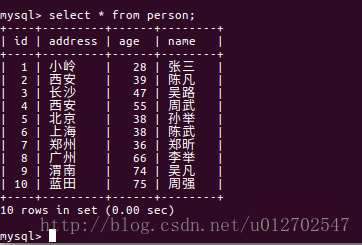
首先我们在浏览器中访问http://localhost:8080/able?id=1,得到如下访问结果:
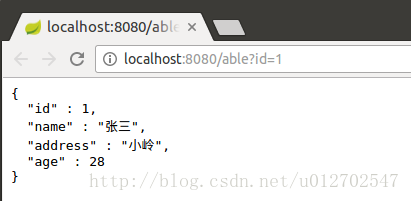
这个时候查看控制台,输出内容如下:

说是数据已经被缓存了,这个时候我们再继续在浏览器中刷新继续请求id为1的数据,会发现控制台不会继续打印日志出来,就是因为数据已被存于缓存之中了。
接下来我们向浏览器中输入http://localhost:8080/put?age=47&name=奥巴牛&address=米国,访问结果如下:
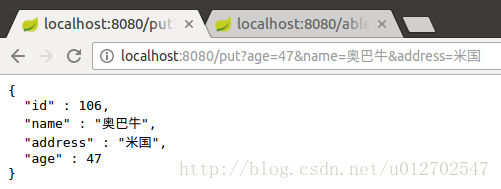
这个时候查看控制台打印的日志如下:

再查看数据表,数据已插入成功:
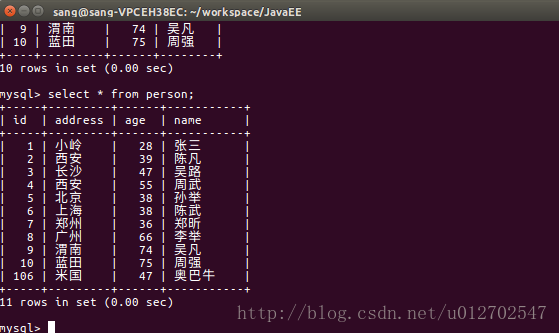
此时,我们在浏览器中输入http://localhost:8080/able?id=106,访问刚刚插入的这条数据,结果如下:
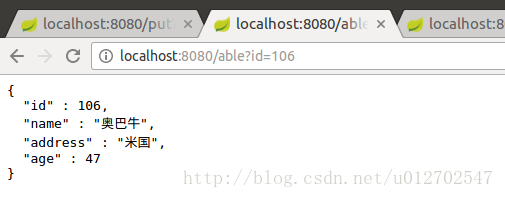
这个时候查看控制台,发现并没有数据数据,就是因为数据已经处于缓存中了。
最后我们在浏览器中输入http://localhost:8080/evit?id=106,将数据从缓存中移除,访问结果如下:

这个时候查看控制台,已经提示缓存移除掉了:

同时数据也从数据库删除掉了,这个时候如果还需要该数据则需要我们继续向表中添加数据。
缓存技术切换
Spring Boot默认情况下使用ConcurrentMapCacheManager作为缓存技术,有的时候你可能想替换为其他的缓存方式,在Spring Boot中进行缓存的切换非常简单,我这里以Google提供的Guava为例,如果要使用这种缓存策略,只需要添加相应的依赖即可,如下:
<dependency>
<groupId>com.google.guava</groupId>
<artifactId>guava</artifactId>
<version>20.0</version>
</dependency>就这样就可以了。实际上在Spring Boot中,底层使用哪一种缓存我们并不必做过多考虑,切换的方式也很简单,如上文引入相应的依赖即可,我们只需要把上层的逻辑写好即可。
本文案例下载:
本文GitHub地址https://github.com/lenve/JavaEETest/tree/master/Test25-Cache.
以上就是本文的全部内容,希望对大家的学习有所帮助,也希望大家多多支持PHPERZ。